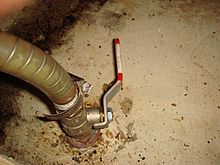Valve Operating Positions
2010-10-08
[edit] Two-port valves
Operating positions for 2-port valves can be either shut (closed) so that no flow at all goes through, fully open for maximum flow, or sometimes partially open to any degree in between. Many valves are not designed to precisely control intermediate degree of flow; such valves are considered to be either open or shut. Some valves are specially designed to regulate varying amounts of flow. Such valves have been called by various names such as regulating, throttling, metering, or needle valves. For example, needle valves have elongated conically-tapered discs and matching seats for fine flow control. For some valves, there may be a mechanism to indicate by how much the valve is open, but in many cases other indications of flow rate are used, such as separate flow meters.
In plants with remote-controlled process operation, such as oil refineries and petrochemical plants, some 2-way valves can be designated as normally closed (NC) or normally open (NO) during regular operation. Examples of normally closed valves are sampling valves, which are only opened while a sample is taken. Examples of normally open valves are isolation valves, which are usually only shut when there is a problem with a unit or a section of a fluid system such as a leak in order to isolate the problem from the rest of the system.
Although many 2-way valves are made in which the flow can go in either direction between the two ports, when a valve is placed into a certain application, flow is often expected to go from one certain port on the upstream side of the valve, to the other port on the downstream side. Pressure regulators are variations of valves in which flow is controlled to produce a certain downstream pressure, if possible. They are often used to control flow of gas from a gas cylinder. A back-pressure regulator is a variation of a valve in which flow is controlled to maintain a certain upstream pressure, if possible.
[edit] Three-port valves
Valves with three ports serve many different functions. A few of the possibilities are listed here.
Three-way ball valves come with a T- or L- shaped rotor. The T valve might be used to permit connection of one inlet to either or both outlets or connection of the two outlets. The L valve could be used to permit disconnection of both or connection of either but not both of two inlets to one outlet.
Shuttle valves automatically connect the higher pressure inlet to the outlet while (in some configurations) preventing flow from one inlet to the other.
Single handle mixer valves produce a variable mixture of hot and cold water at a variable flow rate under control of a single handle.
Thermostatic mixing valves mix hot and cold water to produce a constant temperature in the presence of variable pressures and temperatures on the two input ports.
[edit] Four-port valves
A 4-port valve is a valve whose body has four ports equally spaced round the body and the disc has two passages to connect adjacent ports. It is operated with two positions.
It can be used to isolate and to simultaneously bypass a sampling cylinder installed on a pressurized water line. It is useful to take a fluid sample without affecting the pressure of a hydraulic system and to avoid degassing (no leak, no gas loss or air entry, no external contamination).



